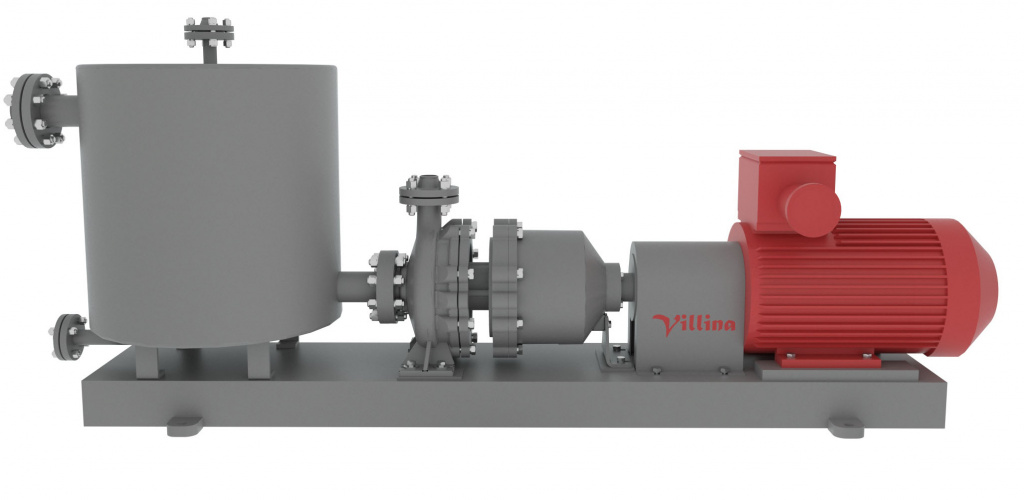The GNGC-S, GNGC-S-M, NCG-S series self-priming centrifugal pumps with magnetic couplings

- Purpose: transit of corrosive, toxic, explosive and flammable fluids at insufficient suction pressure;
- Pump rate ranges: 1.8 to 450 m3/h;
- Head ranges: up to 132 m;
- Self-priming height (depth): up to 6 metres;
- Seal type: magnetic coupling according to API 685 or tandem mechanical seal according to API 682;
- Climatic version: for moderate and for moderate and cold climate;
- Temperature of the pumped fluid: for GNGC-S, GNGC-S-M up to plus 350°С, for NCG-S up to plus 450°С;
- Shaft speed: 1,450 or 2,900 rpm;
- Structural design: ОН-2 single-stage back pull-out pump according to API 610 or a single block;
- Advantages: the fluid can be taken in at a point lower than the axis of the inlet suction pipe without using a pre-installed vacuum pump.
Centrifugal pumps have well-known advantages such as uniform pumping without surges, the ability to create high pressures at low pump rate in multi-stage designs, long service life and others. However, operation of centrifugal pumps requires building positive pressure (pressure boosting) upstream of the inlet suction pipe for the following reasons:
- to fill the pump body with the pumped fluid in order to avoid a "dry start"
- to prevent cavitation during pump operation.
Classic methods for creating pressure boosting before centrifugal pumps can be:
- installation of a tank from which the fluid is pumped, several meters above the axis of the pump shaft and placing the pump in the draw-off sump;
- inclusion of an additional vacuum pump into the process, which is capable of building the desired pressure boosting of several metres.
How is the problem of creating a pressure boosting in modern self-priming centrifugal pumps solved?
Villina company offers you Villina self-priming GNGC series pumps with magnetic couplings and NCG pumps with S series tandem mechanical seals with self-priming depth up to 6 meters, for use in modern processes. Industrial Villina pumps are designed for pumping chemically neutral and corrosive media, and toxic and explosive fluids (including all types of fuel) and can be used in hazardous and highly hazardous manufacturing facilities.
Scope of application
These pumps can be used in any technological processes with insufficient pressure (pressure boosting) in the inlet suction pipe or when fluid intake from a lower level than the axis of the inlet suction pipe of the pump is needed.
Villina self-priming pumps are widely used in oil loading racks where loading and unloading of fuel tanks through the upper drain is provided for. Our product line of self-priming fuel pumps provides a pump rate of 1.8 to 450 m3/h with a head of 3 to 250 meters.
Principle of operation and configuration
The Villina self-priming pumping unit consists of an explosion-proof electric motor and the wet end of the pump equipped with a self-priming device.
The wet end of the pump is connected with the leak-tight pressure chamber (self-priming device) which must be filled with the pumped medium before the initial start-up of the unit. The pressure chamber can be filled with any other fluid compatible with the properties of the pumped medium. Filling is done through a special hole which is sealed with a plug after the required amount has been put in.
When the pump is turned on, during the rotation of the impeller positive pressure is created at the periphery of the "volute", and a rarefaction area is created closer to the center of the impeller. The pumped fluid goes from the pressure chamber to the rarefaction area of the pump wet end through the hole located radially with respect to the impeller, while rarefaction is created in the pressure chamber itself, and consequently, the fluid is sucked into the chamber from the pipeline.
The dimensions of the pressure chamber depend on the diameter of the pipeline upstream of the inlet suction pipe, on the physical properties of the fluid, and the required suction depth. The design maintains the fluid level in the pressure chamber, necessary for filling the wet end, under any operating conditions, and the pump is operated without cavitation.
Advantages of Villina self-priming pumps
The main advantage of Villina self-priming pumps is no need to fill the fluid in the self-priming device during restarts. In addition, a check valve is installed at the bottom of the pipeline to prevent outflow of the pumped medium.
The following advantages are important:
- no leaks and a high degree of tightness of Villina self-priming pumps;
- Villina pumps with self-priming devices occupy almost the same area as conventional centrifugal pumps, since the pressure chamber is placed butt-to-butt with the volute body on a single mount, which provides high maintainability and ease of assembly/disassembly;
- if saving the working area is of prime importance, then the self-priming pump can be made as a single block (GNGC-S-M) requiring 1.5 times less space;
- the possibility of using additional devices that are delivered according to the Customer's specifications: thermal covers, electrical heating systems to maintain the operating temperature, instrumentation and control in accordance with the customer's signal and blocking schematic, frequency drives for efficient adjustment of pump capacity;
- the possibility of applying special coatings to inner surfaces (liners) to increase immunity to corrosive fluids.
You can buy a self-priming pump for fuel, acids, alkalis, alcohols in Villina by calling telephone number (8412) 98-14-28 or sending a request to the email address: villina@villina.ru.
